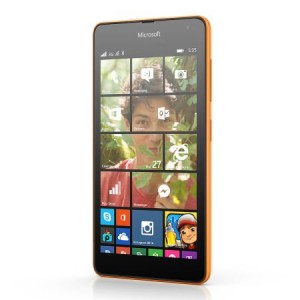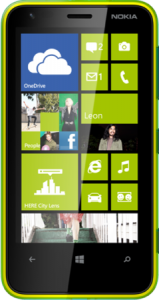This week Microsof took a large step toward becoming a company similar to Apple in building its own branded handsets and delivering them with their own operating system. They don’t have proprietary hardware, like Apple does, but there are quite some similarities between the two, enough for us to observe a trend. The first step Microsoft took in this direction was the unveiling of its first Microsoft-branded smartphone, the Microsoft Lumia 535, which is an inexpensive handset meant to increase Windows Phone’s market share, especially on the Asian market (where it will first be launched). Taking a look at the specifications of the phone, we can see that it is surprisingly similar to one of Nokia’s most popular handsets, the Lumia 620, released in January 2013. Let’s take a look at both phones to see how many similarities we can observe in the specifications of the two.
1. Hardware
First of all, let’s take a look at the basics under the hood. Both handsets come with a multi-core Snapdragon CPU – the Lumia 535 has a Qualcomm Snapdragon 200 processor with four cores and a 1.2 gigahertz speed, while the 620 has a Snapdragon S4 dual-core, at 1.0 GHz. There is a clear evolution here, adding more kick to the Lumia 535’s hardware. The amount of RAM in the 535 was also doubled compared to the 620, but the internal storage space remained the same – 8Gb, almost half of which is occupied by the operating system. When it comes to the GPU, though, the Lumia 620 has a bit of advantage – both handsets have Adreno GPUs, but the one in the Lumia 620 is 50 MHz faster. A bit of video processing power sacrificed for the lower price.
2. The screen
Following today’s trends, the Microsoft Lumia 535 will have a large screen, although not as large as the flagship phones released by the competitors. Its screen will have a 5″ diagonal, with a resolution of 540×960 pixels, which is quite all right, and with a pixel density of approximately 220 ppi. The Lumia 620 has a smaller screen – 3.8″. making it perfect for being navigated with one hand, but less than ideal for gaming – and a smaller resolution (480×800 pixels) but a higher pixel density (approximately 246 ppi), making it one of the best looking screens I have ever seen. Apparently Microsoft Mobile has again sacrificed a bit of display quality for a larger screen, making the handset a bit cheaper.

3. Connectivity
At this chapter we have a tie. Both handsets are delivered with the same options: GPRS, EDGE, WiFi (with tethering) and Bluetooth v4.0. The Lumia 620 has something extra here – it is also equipped with NFC, allowing it to communicate with other NFC capable devices in its vicinity, making it easy to share photos or even pay with it. Neither of the handsets have an infrared port – a feature sought by many who like to use their phones as a remote control.
4. Camera
The Microsoft Lumia 535 is referred to as a “5x5x5″ handset, considering its screen size (5”) and both its cameras having a 5 megapixel sensor. The Lumia 620’s front camera is not that good, having a sensor of only 1.3 megapixels, built into it with video messaging in mind. The back camera on both handsets have the same specs – 5 MP, 2592 x 1936 pixels, autofocus, LED flash, but the Lumia 620 wins at video resolution – it is capable of recording 720p video at 30 fps, while the 535 can only do 480p at the same frame rate.
5. Battery life
The Microsoft Lumia 535 has a considerably larger battery than the Lumia 620 – a 1,905 mAh BL-L4A, compared to a 1,300 mAh BL-4J in the 620. This offers the Lumia 535 more standby time (552 hours vs. 330 hours), more talk time in 3G (surprisingly, the smaller battery of the Lumia 620 offers it much more talk time in 2G networks) and music play. The handset needs the extra power as it has a considerably larger screen to power, and more hardware to run.

6. Other features
One of the features I miss in my Lumia 620 is the FM radio. OK, I know, listening to FM when there are so many online radio stations out there is a bit outdated, but I – and I’m sure many others – still do it on our smartphones (especially because an unlimited data plan costs so much nowadays). The Lumia 535 has it.
Otherwise, both phones look young and colorful, both can play the same media, both come with 15 gigabytes of OneDrive cloud storage and have the same software – Windows Phone 8.1.
7. Conclusion
Considering all the above, I think the Microsoft Lumia 535 is the slightly evolved version of last year’s hit handset, the Nokia Lumia 620. It goes with the trends – it has a quad-core CPU, a large screen, and everything one might expect from a smartphone in its price range. On a personal note – if I were to choose between the two, I would go with Nokia Lumia 620. Not because of the NFC, not because of its excellent screen, but because I am the kind of guy who like to use a phone for talking and a tablet for other things, and not a phablet for both – I’m sure there are many of you out there with the same feelings as me.
Otherwise, I consider the Microsoft Lumia 535 a step in the right direction, away from high profile powerhouses sitting in people’s pockets – a handset with a decent hardware and some more than decent features that are affordable for a larger number of potential users. If it had a smaller screen, I would surely switch to it as soon as it is released.
